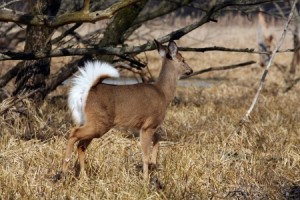Regardless of your skill as a hunter, you won’t kill a buck where there aren’t any. Hunting and shooting skills are essential at the “moment of truth,” but until that time, knowing where to hunt is the most important knowledge you can acquire.
 Although it’s sometimes intuitive or even subconscious, we choose a place to hunt deer based on our knowledge of a species’ habitat requirements. A species won’t be found where one or more of its habitat requirements are missing. It’s that simple.
Although it’s sometimes intuitive or even subconscious, we choose a place to hunt deer based on our knowledge of a species’ habitat requirements. A species won’t be found where one or more of its habitat requirements are missing. It’s that simple.
Certainly other factors come into play. These include hunter access, weather and reproductive success of the species in our gunsights. Also consider climate, predators, disease and road mortality. Of course poaching and game management strategies also come into play, but the availability of a deer’s access to life’s necessities will determine a game animal’s presence and abundance.
In arid regions, the presence of water is the most crucial consideration, but not every source of water is equally valued. Seeps, streams and small water courses are more valuable than an open expanse such as a lake or reservoir. A deer that risks exposure by drinking from an open shoreline is a deer that won’t live very long. Wild animals that learn to eat and drink in private settings live much longer. Look for hidden water sources in areas where water comes at a premium. That’s where you will find older, bigger specimens.
Inexperienced hunters assume that large unbroken tracts of forest hold a lot of deer. On the contrary these tracts are mostly unproductive as they shelter few deer. Forests offer thermal cover and concealment–both of which are essential, but as far as food resources, they offer only starvation rations. That’s largely because of the low light that filters to the ground.
Large populations of deer will be found in open or semi-open tracts of land, where different vegetation types meet and overlap. Examples include edges where pasture and woodland meet or where crops butt up against a forest. A mountain meadow encased by an open coniferous woodland allow deer to thrive. Look for frequent breaks in vegetation, topography and sun exposure. That’s where game will be found.
Once a hunter locates ideal deer habitat, his research may lead to a focus on a particular area that appears especially promising. Frequent and regular forays into prime areas help you learn the specific habitat elements and the trails and times of day when activity is highest. Deer are creatures of habit and learning those habits are the key to a successful hunt. Watch for trails, tracks, droppings and urine stains. Tree rubbings and broken vegetation are also clues to a potentially promising hunt.
Hunters who consistently take larger bucks on public land are those who invest the time to identify the best deer habitat. They also follow up with repeat visits to particularly good tracts of deer habitat. These hunters then invest as much time as is needed to pattern a specific animal and develop a hunting strategy that intercepts that animal when it is most vulnerable.
